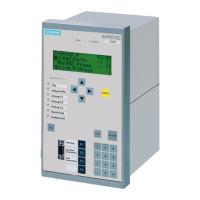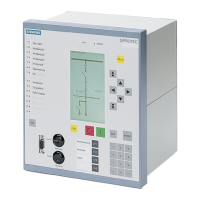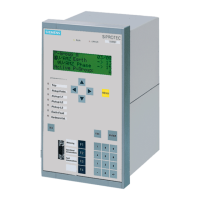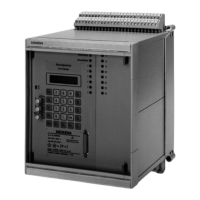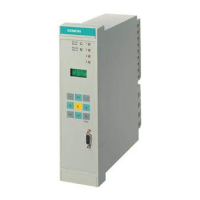breaker protection be affected. Therefore, this operational mode is preferred when a flexible function is not
required to operate as a protection function. Furthermore, the OPERRAT. MODE can be configured.
Three-phase – functions evaluate the three-phase measuring system, i.e. all three phases are processed
simultaneously. A typical example is the three-phase operating time overcurrent protection.
Single-phase – functions evaluate only the individual measuring value. This can be an individual phase value
(e.g. Ι
B
) or a ground variable (Ι
N
).
The setting no reference allows to use external trip commands.
Parameter BLK f out of r allows you to specify whether the protection function is blocked if the meas-
ured power frequency is outside the operating range of the function (25 Hz to 70 Hz). SIEMENS recommends
using the default setting (YES). A release beyond the normal operating range is only required for special appli-
cations.
Measured Variable
In the setting dialog “Measured Variable” the measured variables to be evaluated by the flexible protection
functions can be selected, which may be a calculated or a directly measured variable. The setting options that
can be selected here are dependent on the mode of measured-value processing as predefined in parameter
OPERRAT. MODE (see the following table).
Table 2-12 Parameter “Operating Mode” and “Measured Quantity”
Parameter OPERRAT. MODE
Setting
Parameter MEAS. QUANTITY
Setting Options
Single-phase,
Three-phase
Current
Without Reference
Binary Input
Measurement Procedures
The measurement procedures shown in the tables below can be configured. The dependencies of the avail-
able measurement procedures of configurable modes of operation are also indicated.
Table 2-13
Parameter in the Setting Dialog "Measurement Procedure", Mode of Operation 3-phase
Parameter OPERRAT. MODE = 3-phase
Parameter MEAS. QUANTITY = Current
Parameter
MEAS. METHOD
Fundamental
Only the fundamental harmonic is evaluated, higher harmonics are suppressed. This is
the standard measurement procedure of the protection functions.
True RMS
The "true" RMS value is determined, i.e. higher harmonics are evaluated. This procedure is
applied, for example, if an overload protection element must be realized on the basis of a
current measurement, as the higher harmonics contribute to thermal heating.
Positive seq.,
Negative seq.,
Zero sequence
In order to realize certain applications, the positive sequence system or negative
sequence system can be configured as measurement procedure. Example:
- I2 (tripping monitoring system)
Via the selection zero-sequence system, additional zero-sequence current functions can
be realized that operate independent of the ground variable IN, which is measured
directly via transformers.
Ratio I2/I1
The ratio negative/positive sequence current is evaluated.
Please note that the function only operates if Ι2 or Ι1 has exceeded the threshold value
0.1 · Ι
N
.
Functions
2.13 Flexible Protection Functions
178 SIPROTEC 4, 7SJ61, Manual
C53000-G1140-C210-6, Edition 05.2016
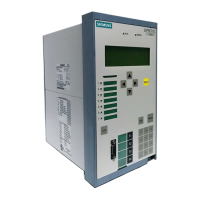
